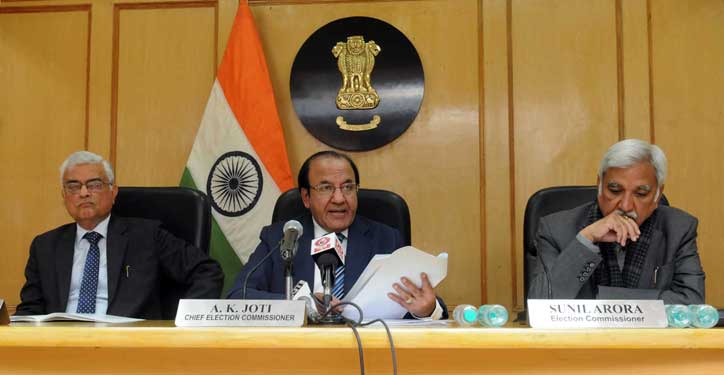 NEW DELHI:
NEW DELHI: The Election Commission of India announced dates for the Assembly elections to Meghalaya, Tripura and Nagaland legislatures on Thursday. The three northeast states are among eight in the country that go to polls in 2018.
Tripura will vote on February 18, while Meghalaya and Nagaland go to polls on February 27. The counting of votes for all states will be conducted on March 3, and the results will be declared on the same day.
Voter Verifiable Paper Audit Trail (VVPAT) machines will be deployed in the three states along with EVMs for the first time for the polls, Chief Election Commission A K Joti said, while addressing a press conference in New Delhi. For the last 20 years, only EVMs have been used, he added.
The Assembly terms of Meghalaya, Nagaland, and Tripura end on March 6, March 13 and March 14, 2018 respectively. The strength of the three Houses is 60 members each.
The Meghalaya Assembly is currently led by the Congress, which won 29 seats in the previous election. The election in Meghalaya is significant for the Congress party, as it is one of the few states under its rule.
The Tripura Assembly is under the CPI(M) government. The BJP and Congress will look to consolidate their positions in the House, with currently just seven and two seats respectively.
The Naga People’s Front is at the helm of the 60-member Nagaland Assembly. The BJP won four seats while the JD(U) bagged one in the last election.
Apart from these three states, elections to the Karnataka, Mizoram, Chhattisgarh, Madhya Pradesh and Rajasthan Assemblies will be held later this year as well.
What is VVPAT? How does it work?Voter Verifiable Paper Audit Trail (VVPAT) machines are used during election process to verify that the vote polled by a voter goes to the correct candidate. VVPATs are a second line of verification and are particularly useful in the time when allegations around Electronic Voting Machines’ tampering crop up. Parties have been making regular demands for VVPATs to be used during elections after alleging EVMs may not be completely secure and tamper proof.
VVPAT system gives instant feedback to the voter showing that the vote polled has in fact been allotted against the candidate chosen.
Working procedure of VVPATsAfter a voter presses the button on the EVM against the chosen candidate, the VVPAT prints a slip containing name of the candidate and the election symbol and drops it automatically into a sealed box. The machines give the chance for the voter to verify their vote. The machine is placed in a glass case in a way that only the voter can see it. The slip is displayed to the voter for seven seconds after which the VVPAT machine cuts it and drops in into the storage box with a beep. The machines can be accessed, though, by the polling officials and not by the voter.
The Election Commission of India has not conceded to any allegation that the EVMs used for polling can be tampered with. However, VVPATs have been used in some elections in a bid to counter all allegation of tampering.
The Supreme Court of India, meanwhile, has for long held a supportive and extra cautious stand when it comes to voting. It had directed the EC in 2013 to introduce VVPAT in Lok Sabha Elections 2014 to improve voter confidence and ensuring transparency of voting. It was used in some phases but not in the entire polling process.
 NEW DELHI: The Election Commission of India announced dates for the Assembly elections to Meghalaya, Tripura and Nagaland legislatures on Thursday. The three northeast states are among eight in the country that go to polls in 2018.
NEW DELHI: The Election Commission of India announced dates for the Assembly elections to Meghalaya, Tripura and Nagaland legislatures on Thursday. The three northeast states are among eight in the country that go to polls in 2018. 